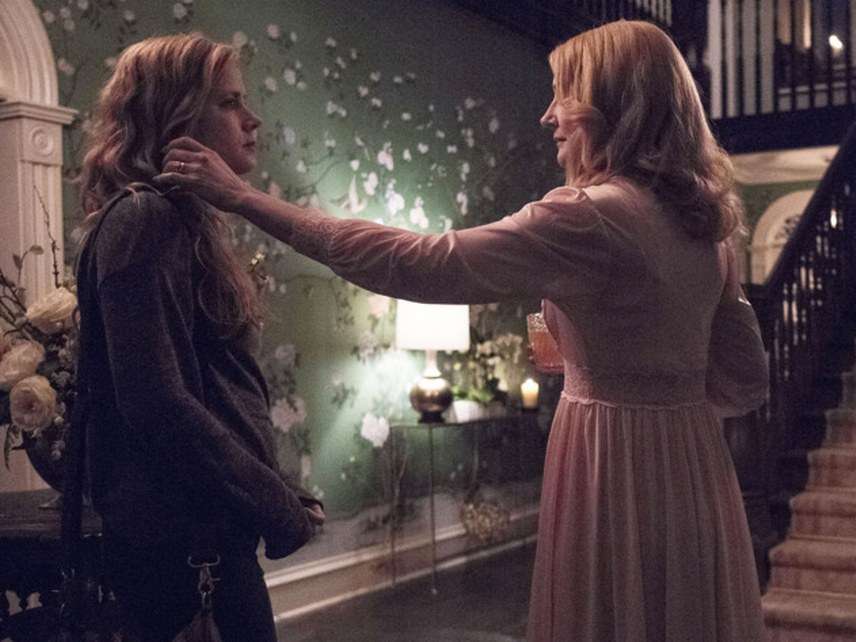HBO's Creaky Adaptation of Sharp Objects Will Make You Want to Stab Yourself
Heavy-handed writing fails to capture Gillian Flynn's dark energy.

Sharp Objects. HBO. Sunday. July 8, 9 p.m.
In the #MeToo era, HBO's Sharp Objects will inevitably be proclaimed a work of eloquent female empowerment. It isn't. It's slow, confusing, over-gothed and under-articulated. There's a good story squeaking from underneath all the messy baggage it carries, but it's probably easier to just go to Kmart for another suitcase rather than unpack this thing.
HBO's miniseries—at eight episodes, probably too long by a quarter—is based on the first novel by creepy-crime writer Gillian Flynn, written some years before Dark Places and Gone Girl made her a star. Though not quite so fluid as her later two books, Sharp Objects shares their disquieting sense that behind every white picket fence there lurks a psychopathic axe murderer about to hack his way out.
The series shares that conceit, but roughly in the same way that your 8-year-old daughter shares with Liberace the desire to play the piano. Amy Adams (Julie & Julia, Justice League) plays the protagonist, newspaper reporter Camille Preaker, whose big-city editor has sent her back to her rural hometown to cover what looks like a serial killer.
Camille is reluctant, ostensibly on the grounds that the story isn't going to win her a Pulitzer. If that had worked, you'd already know it from the gleeful shrieking echoing from every newsroom in America. Instead, the editor retorts, "You're not gonna win a Pulitzer because you're only half-good at writing!"
So off Camille goes, her car stuffed with an industrial supply of vodka, her head with hallucinatory fears flitting around like bats. Her real objection to the assignment is not the distance from Wind Gap, Missouri, to the Pulitzer hunting grounds, but its propensity for racism and rape—a little town where everyone knows, and hates, everyone else.
"My demons are not remotely tackled," Camille tells one old friend who congratulates her for having the strength to return. "They're just mildly concussed." She still literally bears the scars of her childhood, a web of the remnants of old wounds she carved into her body while in the grips of a girlhood compulsion to cut herself, so many of them she won't undress even for sex.
Her demons quickly reincarnate, from the cadre of now-grown up boys who understood "no" to mean, "Bring it, dude," to the girls who cheered them on with catcalls of "Slut!", now ladies who lunch with martinis that loosen their slithering tongues. "I'm not one to talk about other people's touchy areas," one confides. "Not when I'm sober, anyway."
The most dangerous may be Camille's own mother, Adora (Patricia Clarkson, House of Cards), who bullied Camille through a loveless childhood. Adora's fragile appearance is merely a cover for a lethal anger at those who disappoint her.
Or perhaps it is Camille's sister Marian, their mother's favorite, whose teenage death so long ago is still haunting and unexplained. Or even Amma (Australian newcomer Eliza Scanlen), a teenage half-sister she barely knows but in whom she recognizes unnerving similarities to herself.
So: The motif is Southern Gothic, obviously, as it was in Flynn's novel. But series creator and executive producer Marti Noxon (whose other new summer show, Dietland, is bombing like Curtis LeMay over at AMC) doesn't spoon her antebellum gravy, she ladles it.
Every line of dialogue is weighted with hundreds of years of Faulknerian sin, every glance shimmers with the shameful pain of a lacerated hymen. No unforced sex has ever been recorded in Wind Gap, no un-bourboned breath ever taken.
The heavy-handed writing might be less burdensome if it didn't roll out at the pace of a roofied snail. Series director Jean-Marc Vallée (Big Little Lies) has laden the action with endless shots of quiet woods, buzzing insects and every other cliché you can think of (and several you can't) to symbolize the small-town corruption and decay.
And his heavy use of non-linear, jump-cut flashbacks (sometimes no more than split-second images, sometimes even just a sound fragment) renders large chunks of the show nearly incomprehensible. (The fact that Sharp Objects has half a dozen or so teenage-girl characters who seem to have been cloned at the same nail salon does not help.) This is technical virtuosity in service of itself, not the story or characters and certainly not the viewers.
The murkiness of Sharp Objects will likely go unremarked in a Hollywood still feeling the aftershocks of the women-as-playthings scandals that started with the Harvey Weinstein revelation. Instead, the show will be saluted as something akin to journalism, a portrayal of the jagged truth about the way men treat women.
Actually, it's anything but; there are as many abusers as abused among the female characters, and the sharp zigs and zags among them are a bit part of what made it such a compelling novel. Flashes of that can't-put-it-down storytelling are still visible here and there through the overwritten and over-edited debris. That's why I watched five episodes of the seven HBO provided, even as I gritted my teeth the whole time. Color me half-concussed, and sinking fast.


Show Comments (9)